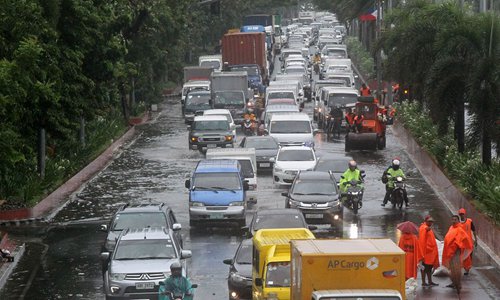HOME >> WORLD
Commuters in Manila try to find their way out of traffic congestion
Source:Xinhua Published: 2019/10/21 13:29:48

Vehicles jam on a flooded road in Manila, the Philippines, Aug. 11, 2018. (Xinhua/Rouelle Umali)
Kit Reyes lives in a city in northern Metro Manila, and works at a call center in Taguig, a city 18 km away but still within the capital city.
Owing to work at 9:00 a.m. local time in the morning, he needs to get up as early as 5:00 a.m. Otherwise he would fail to make it on time.
"The distance sounds manageable, to be honest. But if I don't wake up early, I'll lose my job to traffic, and to the unreliability of the train system," he told Xinhua.
Reyes was not alone in trying to beat the traffic to his job every day in Metro Manila. Traffic congestion is becoming a growing problem for its 12.88 million population.
Felino "Jun" Palafox, the principal architect-Urban Planner and Founder of Palafox Associates, said that the accumulation of these transport problems has the worst effect on commuters who lose nine to 15 years of their 40-year economic lives, by sitting in traffic every day.
Economically, the Philippines is losing a total of 3.5 billion pesos or more than 68 million U.S. dollars in "lost opportunities" due to traffic congestion in a single day, according to a report by Japan International Cooperation Agency (JICA).
Palafox cited the example of the Epifanio Delos Santos Avenue (EDSA), Metro Manila's 23.8 km long circumferential highway that passes through six cities.
"Today, the average speed in EDSA is at 11 km per hour, if it's payday Friday and raining, we are down to only 2. We are like prisoners in the road, because the workability of our major cities has decreased, but the traffic congestion is steadily increasing," Palafox said.
With the current administration's major infrastructure project, the "Build, Build, Build," the transportation department of the Philippines remains optimistic that they will be able to deliver better services to commuters in the coming years.
On Oct. 15, a Chinese manufactured train set was deployed in the Metro Rail Transit System 3 (MRT-3), a transit system that runs in an orbital north to south route along a major highway. It is expected to carry 1,050 passengers per trip. The Metropolitan Manila Development Authority (MMDA), meanwhile, conducts daily clearing operations in an effort to rid roads of illegally parked vehicles and traffic obstructions.
"We are seeing gradual improvements. For instance, our maintenance provider is rehabilitating our rails, we will start the actual digging for the Metro Manila subway system by December, and a new airport outside of Metro Manila is about to be finished," an official from Transportation Department said.
"This short-term struggle among commuters is hard, but let's face it, this is all for a long-term goal of providing them better transport systems. We are focused on that goal," the official added.
Posted in: CENTRAL & SOUTH ASIA